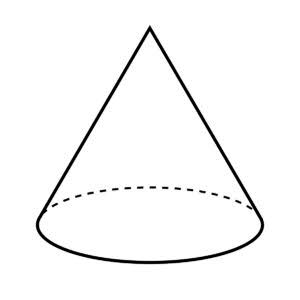
How many vertices does a Cone have?
Answer
502.5k+ views
Hint: In order to the given question, to know the number of vertices of a cone, first we will explain the vertices and then we will talk about the cone and its properties, and then we will also discuss on the shape of cone.
Complete step by step solution:
A vertices is a point where two or more edges intersect
A cone is a three-dimensional geometric shape that narrows smoothly from a flat base (usually circular) to a point called the apex or vertex (which forms an axis to the base's centre). The cone can also be described as a pyramid with a circular cross-section, as opposed to a pyramid with a triangular cross-section.
A cone has one vertex.

Additional information:
A circular cone is another name for these cones. A cone is made up of line segments, half-lines, or lines that link a common point, the apex, to all of the points on a base that are not in the same plane as the apex. The base may be a circle, any one-dimensional quadratic form in the plane, any closed one-dimensional figure, or any of the above plus all the enclosed points, depending on the author.
The lateral surface of a solid object is defined as the boundary created by these lines or partial lines; if the lateral surface is unbounded, it is referred to as a conical surface.
This is a cone with:
$\bullet$ 2 faces (1 curved, 1 circle)
$\bullet$ 1 corner
$\bullet$ 1 curved edge
Note:
Now, one question arises here: Is Cone a Pyramid? So, a cone is a typical pyramid-like figure with a circle or other closed curve as the base rather than a polygon. A cone has a curved lateral surface rather than multiple triangular sides, but both a cone and a pyramid have the same volume.
Complete step by step solution:
A vertices is a point where two or more edges intersect
A cone is a three-dimensional geometric shape that narrows smoothly from a flat base (usually circular) to a point called the apex or vertex (which forms an axis to the base's centre). The cone can also be described as a pyramid with a circular cross-section, as opposed to a pyramid with a triangular cross-section.
A cone has one vertex.

Additional information:
A circular cone is another name for these cones. A cone is made up of line segments, half-lines, or lines that link a common point, the apex, to all of the points on a base that are not in the same plane as the apex. The base may be a circle, any one-dimensional quadratic form in the plane, any closed one-dimensional figure, or any of the above plus all the enclosed points, depending on the author.
The lateral surface of a solid object is defined as the boundary created by these lines or partial lines; if the lateral surface is unbounded, it is referred to as a conical surface.
This is a cone with:
$\bullet$ 2 faces (1 curved, 1 circle)
$\bullet$ 1 corner
$\bullet$ 1 curved edge
Note:
Now, one question arises here: Is Cone a Pyramid? So, a cone is a typical pyramid-like figure with a circle or other closed curve as the base rather than a polygon. A cone has a curved lateral surface rather than multiple triangular sides, but both a cone and a pyramid have the same volume.
Recently Updated Pages
Master Class 9 General Knowledge: Engaging Questions & Answers for Success

Master Class 9 English: Engaging Questions & Answers for Success

Master Class 9 Science: Engaging Questions & Answers for Success

Class 9 Question and Answer - Your Ultimate Solutions Guide

Master Class 12 Economics: Engaging Questions & Answers for Success

Master Class 12 Maths: Engaging Questions & Answers for Success

Trending doubts
Which places in India experience sunrise first and class 9 social science CBSE

Fill the blanks with the suitable prepositions 1 The class 9 english CBSE

Write the 6 fundamental rights of India and explain in detail

Difference Between Plant Cell and Animal Cell

What is pollution? How many types of pollution? Define it

What is the Full Form of ISI and RAW




